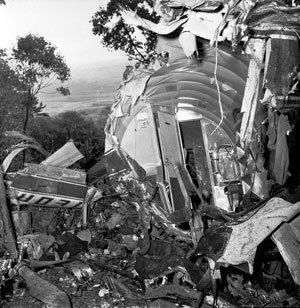Type Boeing 727-22 Registration N68650 Summary Mid-air collision Total fatalities 82 Location Hendersonville | Name Manhattan Pacemaker Date 19 July 1967 Operator Piedmont Airlines Total survivors 0 | |
 | ||
Site Hendersonville, North Carolina Flight origin Asheville Regional Airport Asheville, North Carolina Destination Roanoke Regional Airport Roanoke, Virginia Similar Lake Central Flight 527, Aeroflot Flight 2230, 1967 Nicosia Britannia, Cyprus Airways Flight 284, TWA Flight 128 | ||
1967 Hendersonville Mid-Air Collision was a collision between a Piedmont Airlines Boeing 727-22 and a twin-engine Cessna 310 which happened on 19 July 1967 at Hendersonville, North Carolina, USA. Both aircraft were destroyed and all passengers and crew were killed.
Contents
- Flight and crash
- Original investigation
- Controversy and new investigation
- Notable passengers
- Similar incidents
- References
The aircraft were both operating under instrument flight rules (IFR) and in radio contact with the Asheville control tower, though on different frequencies.
Flight and crash
Piedmont Flight 22 took off from Asheville Regional Airport's runway 16 at 11:58 for an IFR flight to Roanoke, Virginia. While the Boeing 727 was still on its takeoff roll the pilot of the Cessna 310 N3121S reported "Two one Sierra just passed over the VOR, we're headed for the ... for .. ah .. Asheville now." The Approach controller then cleared the Cessna to descend and maintain 6000 feet. At 11:59:44 the controller cleared Flight 22 to "... climb unrestricted to the VOR, report passing the VOR". He then cleared the Cessna for an approach to runway 16. The 727 was still climbing, when the Cessna slammed into the plane just aft of the cockpit, and disintegrated. Many witnesses reported the collision as sounding like a jet breaking the sound barrier. The 727 rolled onto its back, and crashed vertically into a camp known as Camp Pinewood, exploding on impact.
Original investigation
This was the first major airline accident investigated by the National Transportation Safety Board (NTSB), newly formed to replace the Civil Aeronautics Board (CAB). The NTSB's report placed the primary responsibility for the accident on the Cessna pilot, while citing air traffic control procedures as a contributing factor, and recommended a review of minimum pilot skill levels required for IFR flight.
Controversy and new investigation
In 2006, however, 39 years after the accident, the NTSB agreed to reopen the investigation because of apparent irregularities identified by Paul Houle, a historian who spent several years studying the accident. Houle alleged the following problems with the NTSB's original investigation:
Houle also mentioned that, at the time, the newly formed NTSB was not fully independent of the Federal Aviation Administration (FAA), since both reported to the Department of Transportation. Houle claimed that these conflicts of interest led the NTSB to avoid citing either Piedmont or FAA controllers as primary causes of the accident.
In early 2007, the National Transportation Safety Board (NTSB) decided to confirm their original findings, upholding the probable cause it found in 1968 for the midair collision. In a February 2007 letter, the NTSB notified Paul Houle it had voted 3-1 that his arguments were unsubstantiated (Letter from Mark Rosenker, NTSB Chairman, February, 2007).
Notable passengers
John T. McNaughton, Assistant Secretary of Defense for International Security Affairs and Robert McNamara's closest advisor, was a passenger on Flight 22, along with his wife and younger son.
Similar incidents
John Keel in his book Operation Trojan Horse mentions the North Carolina crash as a fulfillment of prophecies of plane crashes in 1967, given to UFO contactees. Originally published in 1970, Keel writes: "the next day, 20 July, an identical accident occurred in Brazil, killing some leading Brazilian politicians."
